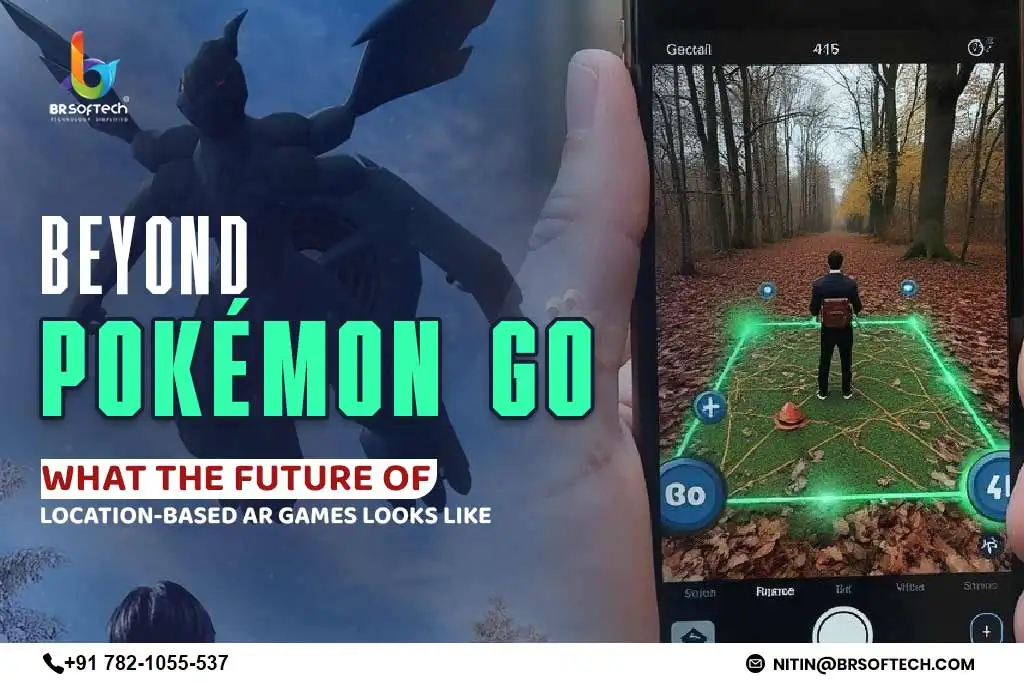Nearly a decade has passed since Pokémon Go reshaped the gaming landscape with its groundbreaking use of AR technology. The industry has only moved uphill since then. The technology has gone beyond catching Pikachu in the park and is pushing boundaries with emerging technologies, deeper real-world integrations, and more immersive gameplay experiences.
Despite the advancements, the doors to innovation remain wide open. The AR landscape continues to soar, and the future has even better plans. Moreover, the future of AR games is not limited to a few genres; it might also blend with areas like education and fitness.
In this blog, we shall discuss implementations of AR in the gaming landscape and beyond. Stick till the end to understand the potential of AR in the gaming world in the near future.
How Will Real-World Integration Get Smarter?
AR games of the future will go beyond static geolocation. Real-time data will be integrated into the game, for example:
- Weather
- Traffic conditions
- Time of day
- Event-specific elements, like concerts or sports games
The gameplay will adjust to the environment, and the narrative will suit the land’s geography. Players living in different time zones will experience different game mechanics, and integration of AI will also be in the loop to make it more exciting.
- AI-enhanced interactivity
- Dynamic real-world integration
- Environment-based gameplay
- Geo-adaptive narratives
- Time zone-specific mechanics
Key Trend:
Context-aware gameplay that responds to your surroundings in real-time can be a common thing in futuristic games.
What Are AI-Powered NPCs and Dynamic Storytelling?
Advancements in generative AI and natural language processing are making it possible for AI-driven NPCs to interact with players naturally. Instead of scripted events, based on their actions and movement through real-world locations, players can:
- Engage in fluid conversations
- Receive quests
- Influence evolving storylines
AI will play a big role in Augmented Reality games of the future. The conversations that will happen in the storyline between characters will be a product of AI. Moreover, it will be dynamic and will depend on the user’s behavior. Developers, with the help of machine learning, will create environments where unpredictability plays a significant role in the gameplay.
Example
A virtual detective game where an AI character gives you clues tied to your physical neighborhood. Now, each player who plays the game will have distinct clues, and the ways of solving the crime will also be different, promoting dynamic storytelling.
Also Read: Top AI-Powered Games You Must Try in 2025
How Will Developers Tackle Latency in AR Games?
Latency is a big issue players face while playing their favorite AR games. This issue is being tackled by the rollout of 5G networks and edge computing. And it will allow players to experience real-time multiplayer in AR games. This means smoother, more complex gameplay involving simultaneous actions across large areas without lag, ideal for large-scale events, battles, or scavenger hunts.
It is impossible to play AR games on a WiFi, as most of the games require us to roam, the best example being Pokémon Go. Therefore, if your internet connection is slow, you may face latency, resulting in a poor game experience. With 5G and edge computing, latency will be tackled in the future in AR games
What Will Be the Core Experience in AR Games?
AR games are predicted to lean heavily towards cooperative and competitive multiplayer games. Whether you’re teaming up with friends to take down a boss at a local park or challenging strangers in a city-wide AR tournament, social interaction will be baked into the core loop.
Social interaction will be the focal point of AR games, since people are more inclined towards being in each other’s lives through games. Countries focus a lot on developing games that push the boundaries of social interaction, especially Japan.
Innovative Possibility:
Forming in-game guilds based on your city or local community will give rise to social interaction.
How Will Wearable AR Tech Change The Gaming Landscape?
Wearable AR tech will unlock hands-free gaming. With smart glasses, players will soon be able to ditch their phones for more immersive and hands-free experiences. Instead of staring down at a screen, gameplay will unfold around you, fully integrated into your physical space with the help of devices like:
- HTC Vive
- Apple Vision Pro
- Meta’s AR device
- Snap Spectacles
Can We Integrate NFTs and Blockchain in AR Worlds?
Though still controversial, blockchain and NFTs may play a bigger role in the future of AR games. Items earned in one location could be traded globally or carried between games, forming part of an interconnected multiverse of AR titles.
How Will AR Technology Gamify Urban Exploration and Tourism?
Tourism boards and museums are already experimenting with AR to engage visitors. Cities like Dubai are leveraging AR technology to provide immersive experiences to travelers. Future games could blend education, history, and entertainment, encouraging players to discover hidden gems, complete real-world challenges, and unlock achievements tied to culture and landmarks.
Use Case:
- A historical AR game that unlocks different storylines as you visit monuments in a city.
What Other Genres Will Rise Apart From Gaming?
Location-based fitness games are expected to rise. Pokémon GO accidentally became a fitness app for many because of its game mechanics that urged players to go out. This phenomenon gave ideas to newer games that are intentionally combining health tracking and AR gameplay. Expect future titles to gamify exercise, walking, and biking, encouraging real-world movement with tangible in-game rewards.
Final Thoughts
If you wish to develop an AR game, you can contact an AR game development company. Building an AR game will help you create smooth revenue streams, and it will help elevate your brand’s image in the market.
FAQs (Frequently Asked Questions)
Q1: What are the best location-based AR games like Pokémon GO in 2025? Ans. In 2025, several AR games have stepped up with innovative gameplay beyond Pokémon GO. Some of the best alternatives include:
Peridot (Niantic): A virtual pet experience with deep emotional bonding and real-world interaction. Pikmin Bloom (Nintendo/Niantic): Gamifies daily walks with adorable flower-planting mechanics. The Witcher: Monster Slayer (Spokko): An RPG experience that brings monster hunting to your neighborhood. Jurassic World Alive (Ludia): Allows players to collect, evolve, and battle dinosaurs based on real-world locations. Ghostbusters Afterlife: ScARe (Trigger XR): A cinematic AR experience tied to the Ghostbusters universe.
Q2: What makes a successful location-based AR game in the post-Pokémon GO era? Ans. Modern AR games need more than GPS mechanics to succeed. Key factors include:
Real-time interaction with surroundings (e.g., weather, time, and events)
Immersive storytelling and character depth, Multiplayer or co-op elements
Fitness or lifestyle integration, Cross-platform availability, including AR glasses and wearables.
Q3: How are AR games expected to change with wearable technology like smart glasses? Ans. Smart glasses and AR headsets like Apple Vision Pro, Meta Quest 3, and Snap Spectacles are game-changers. With these devices, AR games will:
Become hands-free and more immersive. Use spatial audio and environmental awareness to guide gameplay Deliver 3D overlays and gesture-based controls instead of touchscreen input Offer seamless integration into daily life (e.g., find a treasure chest while walking your dog) This shift will enable more natural, always-on AR experiences, making the physical world the game board.
Q4: What role will AI play in the next generation of location-based AR games? Ans. AI will fundamentally enhance location-based games in several ways:
Dynamic NPC behavior: Characters that respond contextually to your choices and location. Procedural content: Missions, items, or enemies generated based on your environment and movement. Conversational AI: Natural-language dialogues with virtual companions, mentors, or quest-givers.
Personalization: AI adapts difficulty, storyline, or rewards to your playstyle and travel habits.
Q5: Will blockchain and NFTs really impact location-based AR gaming? Ans. Yes, but the impact will vary by audience and implementation. Potential use cases include:
Geo-tagged digital collectibles: NFTs tied to real-world places, like historical landmarks or limited-time events. Interoperable avatars and items: Use your blockchain-based sword or pet across multiple games.
Player-owned economies: Trade, rent, or sell in-game assets tied to real-world effort and discovery.
While some players are skeptical, developers are experimenting with ethical, sustainable NFT integration that adds value without pay-to-win mechanics.
Q6: Are AR games good for fitness and mental health? Ans. Yes. Location-based AR games promote physical activity and outdoor exploration. Benefits include:
Increased daily steps and cardio through walking quests
Mental stimulation via puzzles, strategy, and exploration
Social interaction, which helps combat loneliness and screen fatigue
Mindfulness and mood improvement from being outdoors
Q7: How can developers get started building a location-based AR game? Ans. To build a location-based AR game, developers typically use:
Unity + AR Foundation: Ideal for cross-platform development (iOS + Android)
Niantic Lightship SDK: Purpose-built for creating real-world AR experiences with mapping and multiplayer.
ARKit (iOS) & ARCore (Android): Native AR development tools from Apple and Google.
Mapbox and OpenStreetMap APIs: For geo-spatial mapping and location tracking.
Photon or Agora: For real-time multiplayer functionality.










